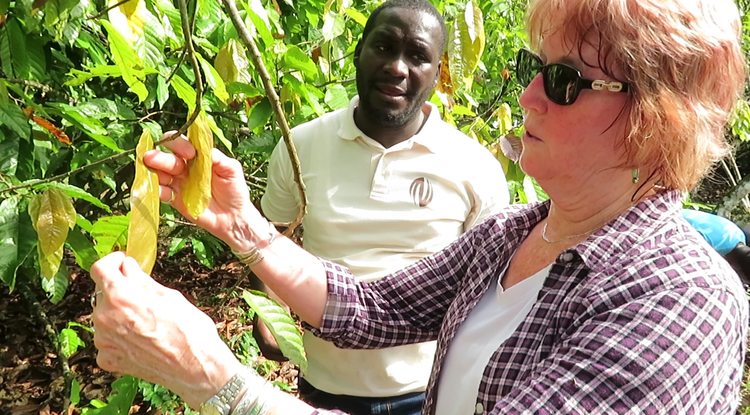Ravaged by a poorly studied disease, cacao trees are dying. A University of Arizona plant scientist is on a quest to figure out what makes them sick — and develop tools that will help growers fight for their livelihood.
Picture this: It’s Valentine’s Day, and you head out to buy some pralines. Except you can’t find any. No matter which store you visit, gummy bears and hard candy have taken the place on the shelves where the chocolate hearts used to be.
Researchers warn that this scenario could become reality sooner than you might think.
About 70 percent of the world’s production of cocoa — chocolate’s main ingredient — comes from just six small countries of West Africa, where a blight disease that kills cacao trees is spreading rapidly, causing decline and death in some trees in less than one year after infection occurs. In its wake, the livelihood of farmers is at stake and rainforest is lost as growers expand their plantations to compensate for losses.
“There is almost no knowledge about who and where the enemy is — let alone what actions are needed to ensure the longevity of the crop in the region for the short and long terms,” says Judy Brown, a plant virologist at the University of Arizona’s College of Agriculture and Life Sciences who is working with African scientists and farmers to create greater awareness and develop ways to combat this disease.
“The impact on farmers and their families in terms of health, food security and sociopolitical aspects is dire, and continues to be, as the rapid tree decline outbreak affects more and more trees.”
Chocolate’s Worst Enemy
Little is known about the pathogen — especially its diversity — other than it being a virus that infects cacao plants and is transmitted by mealybugs, small insects that feed on the tree sap. Unlike most other major crops, which have been backed by a history of research to make them more productive, better adapted to environmental stresses and more resistant to disease, cacao essentially is still a wild plant largely neglected by research and improvement programs, including badly needed epidemiological studies to guide management, Brown says.
“This has resulted in a situation that is like going to the doctor and being told, ‘Sorry, we have no way to test your blood, so we can’t tell you whether you ate something poisonous or you’re just lacking vitamins,'” she says.
For more than 100 years, the “solution” has been to remove infected trees and replace them with healthy trees, according to Brown. This strategy is destined to fail in the long run, because by the time trees show symptoms, they have been infected for weeks or months, all the while spreading the virus to neighboring trees.
The affected countries in West Africa are gearing up to remove infected trees, with more than 300,000 infected cacao trees being replaced in Côte d’Ivoire alone.
“This comes at an enormous expense, while research to understand the distribution of disease spread and to identify the specific sources of the viral pathogens has been minimal,” says Brown, underscoring the need to learn much more about the nature, origin and cause of the outbreaks.
Fishing for Genetic Fingerprints
Brown is determined to help change that. In collaboration with the U.S. Department of Agriculture’s Agricultural Research Service in Miami and Mars Inc., the candy company, her research group is developing molecular tools growers could use to spot infected cacao trees before they show symptoms.
“First, we have to get a better idea of who the enemy is,” Brown says. To that end, her research group takes advantage of “deep genome sequencing,” a technology that seemed like science fiction just 20 years ago, when the technology was first developed to decipher the human genome.
“We take leaf tissue samples from infected cacao trees and fish for genetic material,” she says. “This type of next-generation DNA sequencing is fairly new technology, and it allows us to look for unknown or undiscovered viruses in our samples.”
Through a collaboration with researchers from Côte d’Ivoire, Ghana and Nigeria, Brown’s group obtained leaves from cacao plants showing swollen stems and different patterns of leaf and vein discolorations, the telltale signs of being affected by swollen shoot disease viruses. After just one round of deep sequencing, the researchers found that the virus that gave the disease its name — cacao swollen shoot disease — was in fact six or more different species, and they expect to discover more.
“There is very little understanding of the genetic diversity of these viruses, or what that means in relation to how they interact with their host plants and their mealybug vectors,” Brown says. “It’s a complete black box.”
Of the previously unknown virus species, formerly known as cacao swollen shoot virus, or CSSV, one appears to be particularly deadly, according to a recent publication by Brown’s team. The cacao trees that it infects develop red blotches along the veins of its leaves, and they die within one to two years, before farmers can get even one crop out of them.
“We still are just at the tip of the iceberg,” Brown says. “We think there are several more species to be discovered, and the unexpected, high amount of genomic diversity we have seen tells us that the viruses are undergoing rapid change.”
Virologists like Brown know what this means.
“You see a similar pattern in other viruses like HIV and Ebola,” Brown says. “It tells us the virus is under pressure to find a niche. It’s trying to sort itself out and arrange its existence with the new host, and that tells you it is an emerging pathogen.”
In its native habitat, the Amazon basin, cacao plants have had time to arrange their existence with the pathogens in that area, but that all changed when colonists brought the crop over to Africa in an attempt to grow the commodity closer to European consumers.
From New World to Old World
“Imagine taking these naïve cacao plants to a new continent, into an environment they’re not adapted to, with all those different plant viruses they have never encountered, and asking them to run, to grow and thrive and make pods containing chocolate beans,” Brown says. “Because commercially grown cacao never was systematically bred, it has very narrow genetic diversity, and even if it does have some resistance, all the viruses need to do is reshuffle their genomes to overcome that.”
Without molecular and bioinformatics tools and knowledge, the population depending on cacao may succumb to pandemics, experts fear.
“Their whole livelihood depends upon it,” Brown says. “If they have no income, they have no food, they have no clothes, no antibiotics, the kids don’t go to school. The same thing just happens in circles when people are weakened and live in poverty.
“The sequence data may sound esoteric but it is not, because it helps us understand a lot about the viruses and their epidemiology, much like the Centers for Disease Control does for HIV or Ebola. It helps with diagnostics so the growers know what they’re dealing with, as well as with long-term breeding efforts to help them make the best decisions to stave off the damage until a more permanent, knowledge-based solution is in hand.”
Early detection, while an important first step, can be only part of the solution. The more dependent farmers are on cacao alone, the less likely they are to implement preventive measures against the blight.
‘Pods Are Currency’
“No farmer wants to cut down a tree that still has pods on it,” Brown says, “because pods are currency, and if that’s their only income, they can’t afford to start over, replant everything and wait several years until the new trees make pods.”
Brown works closely with scientists from West African cacao-producing countries — Cameroon, Ghana, Ivory Coast, Liberia, Nigeria and Togo — and hopes they can be involved in a much greater way in tracking the virus in wild forest trees that are thought to serve as reservoirs, managing the insect vectors as well as gaining access to short- and long-term training and scientific equipment.
During a recent trip to Côte d’Ivoire, Brown and local experts explored the possible use of drones to survey cacao plantations and spot infected trees. In addition to developing effective diagnostic tools, researchers hope to be able to take advantage of emerging biotechnological trickery such as the CRISPR gene-editing tool to create cacao cultivars that are resistant to viruses and other pathogens.
“One thing that scientists are really good at is to break down barriers and share knowledge and the excitement of learning and move it into some kind of action, and that will help solve the problem,” Brown says. “We are such nerds in that way.”
Source: University of Arizona












